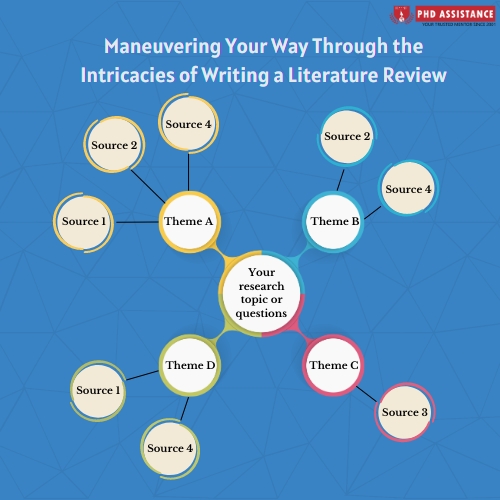Maneuvering Your Way Through the Intricacies of Writing a Literature Review
Introduction
A literature review has been described as a critical analysis and synthesis of prevalent research pertaining to a topic currently under investigation, and usually tends to be an integral aspect of a larger research thesis or paper. The beauty of a literature review is that it helps a researcher to identify gaps, opposing opinions, and trends within the literature. At the same time, a researcher is also able to refine the research question and methodology in accordance. Nonetheless, it is easier said than done. Writing a literature review can be a daunting task and can be challenging wherein the foremost challenge would be finding the relevant sources, organizing the sources, synthesizing sources, maintaining coherence, and writing style amongst others. This particular piece would familiarize you with a few common challenges and outline strategies to help you overcome those challenges.
Challenges Commonly Encountered
Finding the Right Sources
A literature review commences with finding and selecting the right sources. Sources that are pertinent, valid, and would enrich your review. Usually, scholars opt for a generic search or the smarter ones’ search for papers in the various scholarly databases. In either case, it is also imperative to assess sources for their authority, quality, and currency. Here, scholars need to factor in the date of publication, the credentials of the author, the scope and coverage of the source, the arguments and evidence offered, and the use of references (Mitchell & Rich, 2022). Scholars could also opt to utilize tools like citation analysis, peer review, and impact factor to evaluate the relevance and impact of the source.
Organizing the Sources
Following the collection and analysis of sources, the papers must be organized such that it enables a scholar to compare and contrast their key points, methods, findings, and implications. Different methods can be utilized for organizing sources, like chronological, thematic, methodological, or even theoretical (Pagliarussi, 2020). Scholars could also opt to utilize tools like matrices, tables, charts, or maps for visually presenting and categorizing their sources. The key here would be to group sources as per common pertinent themes, gaps, or patterns that might emerge from their analysis and to link them with their research questions and objectives.

Figure 1: Thematic Organization of Sources
Source: The thematic organization of the literature review in scientific articles, Pagliarusi, 2020
Synthesizing the Sources
Synthesizing the sources is nothing but incorporating and blending the ideas and information across varied sources into a seamless and coherent whole. Simple summary or rephrasing of every individual piece of literature would not help, rather it is recommended that you indicate how they are associated with one another, and also to your viewpoint or argument. To synthesize each source, you could use diverse methods like recognizing similarities and variations, comparing and contrasting, finding links and associations, and arriving at conclusions or highlighting their implications (Brendel et al., 2020). Furthermore, you would also be required to use connectors, transitions, and signposts to help your reader through your synthesis while indicating how you develop on or are challenging the current literature.
Maintaining Coherence
Maintaining coherence is often a challenge, considering that literature reviews are vast and voluminous. In order to effectively convey your ideas, you must maintain coherence and structure throughout your literature review. In the absence of a coherent structure, readers might find it challenging to understand your arguments or get the gist of what you are trying to convey. In order to overcome this challenge, it would help if you first developed a detailed outline for your literature review prior to commencing the writing process. Furthermore, you could split your literature into sections and sub-sections based on themes. Every section should be clearly introduced, discussed, and closed with a summary. The progression from one section to the other should be seamless and in a proper flow so that there are no jumps between sections by highlighting the link between the sections.
Writing Style
Seeking a proper balance between a writing style that is formal and engaging can present a challenge. Though academic writing warrants precision and clarity, you must engage your readers and capture their interest throughout. To tackle this challenge, you should perceive your target audience and the reason for writing the review (V, 2023). Always stick to simple language and refrain from going overboard with technical terms or jargon. Integrate rhetorical questions and transitional phrases to bring in variety and to enrapture your audience. It would also help to simplify complex concepts and offer examples to present your arguments effectively.
Conclusion
As mentioned, writing a literature review is a tedious task and would require much focus, dedication, and perseverance to do so. Also, given that it makes up the major chunk of a research project, there is a possibility for a scholar to lose focus along the way. However, it is not an impossible task. A literature review can be effectively conducted if the above pointers are kept in mind. Scholars could also take the easy way out by outsourcing the task of writing a literature review. PhD Assistance presents researchers with cohesive literature review writing services, along with a whole gamut of associated services. PhD Assistance has been serving scholars, researchers, and the student community for more than a decade now. Experts at PhD Assistance are highly qualified and experienced professionals with expertise in several domains and are adept at writing literature reviews and other associated project works.
References
- Brendel, A. B., Marrone, M., Trang, S., Lichtenberg, S., & Kolbe, L. M. (2020). What to do for a literature review? – A synthesis of literature review practices. 26th Americas Conference on Information Systems, AMCIS 2020, May. https://www.researchgate.net/publication/341381026_What_to_do_for_a_Literature_Review_-A_Synthesis_of_Literature_Review_Practices
- Mitchell, A., & Rich, M. (2022). challenges of writing an effective literature review for students and new researchers of business. European Conference on Research Methodology for Business and Management Studies, 21(1), 141–148. https://doi.org/10.34190/ecrm.21.1.169
- Pagliarussi, M. S. (2020). The thematic organization of the literature review in scientific articles. Revista de Contabilidade e Organizações, 14, e169787. https://doi.org/10.11606/issn.1982-6486.rco.2020.169787
- V, D. T. (2023). Research Articles Writing Styles and Procedures Future Improvement with Source for Review of Literature. SSRN Electronic Journal. https://doi.org/10.2139/ssrn.4461856
 Previous Post
Previous Post
